Halva
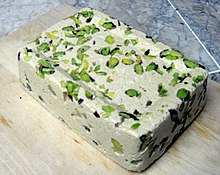 | |
| Type | Confectionery, dessert |
|---|---|
| Region or state | Middle East, South Asia, Central Asia, Balkans, Caucasus, North Africa, Horn of Africa |
| Serving temperature | Cold |
Halva (also halvah, halwa,[1] and other spellings; Persian: حلوا) is a type of confectionery originating from Persia and widely spread throughout the Middle East and South Asia. The name is used for a broad variety of recipes, generally a thick paste made from flour, butter, liquid oil, saffron, rosewater, milk, cocoa powder, and sweetened with sugar.[2][3][4][5]
Etymology
The word halva entered the English language between 1840 and 1850 from Romanian, which came from
History
Halva originated in
Many of the earlier Persian recipes were documented in the 13th century Arabic book Kitab al-Tabikh (The Book of Dishes), as well as an anonymous cookbook from 13th-century Al-Andalus. Halva was adopted by the Ottoman Turks, including a sesame-based version, and spread throughout their empire.[6]
Types
Most types of halva are relatively dense confections sweetened with sugar or honey.[11] Their textures, however, vary. For example, semolina-based halva's texture can be like a very buttery, moist clumpy couscous[12] to something gelatinous and translucent, while sesame-based halva is drier and more crumbly.[13]
Grain-based halva
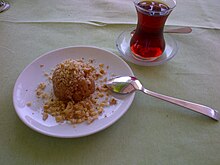
Grain-based halva is made by toasting flour or cornstarch in oil, mixing it into a roux, and then cooking it with a sugary syrup. Corn is rarely used.
Dishes made from wheat semolina include suji ka halwa (sooji sheera, rawa sheera) in India and irmik helvası in Turkey. The semolina is first toasted in fat, either oil or butter, to which water or milk, and sugar is added as desired to create the preferred taste and consistency.[14]
Dairy-based rice flour halva, known as Pathein halawa, is considered a Burmese delicacy native to the city of Pathein.
Sesame
Sunflower
Peanuts
In Argentina, Greek immigrants at the beginning of the 20th century created a kind of halva called mantecol from peanut butter, currently marketed under the name of Mantecol and also Nucrem. Such a product is widely consumed in the country.
Other
Floss halva
A similar chickpea-based, version of floss halva is popular in North India. It tends to be slightly denser and is often referred to as patisa or
A raw version of halva also has become popular among proponents of raw food diets. In this version, a mixture of raw sesame
Cultural and national variations
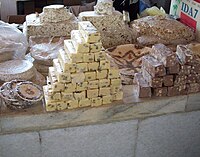
Azerbaijan

One regional variant is from
Greece
Halva is a traditional fasting food among Greek Orthodox who traditionally have food restrictions, especially from meat, on Wednesdays and Fridays throughout the year, for all of Great Lent and other fasting periods.[25]
India


India has many types of halva, some unique to particular regions of the country. It is one of the popular sweets of India usually made from semolina.[26]
The town of
It is speculated that Halva (or Halwa) is associated with Indian traditions and culture, written records of sweets from Mānasollāsa indicate that semolina halvas, the most popular form of halvas in India, were already known in India, for instance, it mentions a sweet called shali-anna which is a semolina based sweet today known as Kesari in South India.[29]
Tirunelveli in Tamil Nadu is known for its wheat halwa. Its preparation is a laborious process that "is slowly seeing this sweet disappear." Unlike other sweets, the extra ghee is not drained out but forms an outer layer. This increases the shelf life of the halwa. The unique taste of the halwa is attributed to the perennial Thamirabarani.[30]
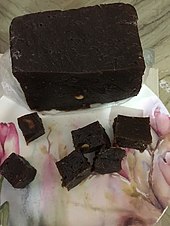
The history of
Iran
In Iran, halva (Persian: حلوا) usually refers to a related confection made from wheat flour and butter and flavored with saffron and rose water.[34][35] The final product has a yellow color or brown color or dark brown color. The halva is spread thin on a plate till it dries into a paste. Halva usually is served at wedding celebrations, religious ceremonies and funerals.

Halva Ardeh is the Iranian term for tahini-based halva, and may or may not include whole pistachios. Ardeh is processed sesame in the form of paste, usually sweetened with syrup.[36][37]
Israel
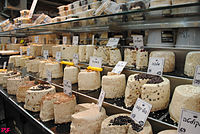
Tahini halvah (
Myanmar (Burma)
In
Turkey
In
For this reason, flour (un) halva is also called in Turkish ölü helvası, meaning "halva of the dead". The expression "roasting halva for someone" suggests that the person referred to has died.
United States
Halva can be found in ethnic Indian, Jewish,[6] Arab, Persian, Greek, Balkan, and Turkish community stores and delicatessens. It is increasingly offered by upscale restaurants in some areas.[42] Besides being imported, it is manufactured in the United States, with the largest producer being Brooklyn-originated Joyva.[43][1]
See also
References
- ^ a b Clark, Melissa (March 24, 2004). "For Halvah, Use 1/2 Cup Nostalgia". The New York Times. Retrieved November 15, 2020.
- ^ ISBN 0-19-211579-0.
- ISBN 9780195633757.
- ISBN 978-1-903018-79-8. Retrieved April 11, 2022.
- ^ Szokovski, Miriam. "How to Make Halva at Home".
- ^ ISBN 9780544186316.
- Random House Dictionary, 2009
- ^ "American Heritage Dictionary". Retrieved February 21, 2019.
- ^ a b Foundation, Encyclopaedia Iranica. "Welcome to Encyclopaedia Iranica". iranicaonline.org. Retrieved April 23, 2021.
The origin of ḥalwā in Persia dates from the pre-Islamic period. References are found in the Middle Persian text of Xōsrōv ud rēdak (ed. Monchi-zadeh, secs. 38-40) to two kinds of sweetmeats (rōγn xwardīg): (1) summer sweetmeats, such as lōzēnag (made with almond), gōzēnag (made with walnut), and čarb-angušt (made from the fat of bustard or gazelle and fried in walnut oil); and (2) winter sweetmeats, such as wafrēnagītabarzad flavored with coriander (gišnīz ačārag). Many references are found to ḥalwā in classical Persian texts, but rarely do they provide details concerning ingredients.
- ISBN 978-0-544-18631-6.
Halva is a dense confection. The original type is grain based, typically made from semolina, and another kind is seed based, notably made from sesame seeds. Origin: Persia
- ^ Kobren, Gerri (August 17, 1983). "What's this stuff called halvah?". The Herald News (Passaic, New Jersey). Independent Press Service. p. C-4. Retrieved August 17, 2022 – via Newspapers.com.
- ^ "Suji ka Halwa | Sheera Recipe". July 3, 2021.
- ^ Shah, Khushbu (June 8, 2017). "Halwa vs. Halvah: An Investigation". Taste. Retrieved March 8, 2019.
- ISBN 9781635574418.
- ISBN 978-1-56022-031-2.
- ^ "Halva Ethnological Museum of Thrace". Archived from the original on July 3, 2007.
- ^ "HALWA+WITH+PISTACHIO" "Halwa with pistachio". FAO Food and Nutrition Paper. 25–28. Food and Agriculture Organization of the United Nations. 1982.
- S2CID 54789320.
- ^ "Халва. Общие технические условия", Гост 6502-2014, Межгосударственный совет по стандартизации, метрологии и сертификации, 2014 ["Halva. General specifications", Interstate Standard GOST 6502-2014 (in Russian), Euro-Asian Council for Standardization, Metrology and Certification, 2014]
- ^ "Халва". ГОССТАНДАРТ. "Halva" (in Russian). GOSSTANDART. Archived from the original on January 13, 2021. Retrieved May 1, 2019.
- ISBN 9789667127008.
- ISBN 978-0-06-084318-2.
- ^ "Visions of Azerbaijan Magazine ::: SHEKI'S MYSTERIES – STAINED GLASS AND THE SWEETEST HALVA". Visions of Azerbaijan Magazine.
- ^ "Mətbəx sirləri: Şəki halvası - VİDEO". Milli.Az. March 20, 2013.
- ^ Moskin, Julia (April 11, 2016). "Sesame Extends Its Sweet Reach Beyond the Middle East". The New York Times.
- ISBN 81-86112-23-5.
- ^ "ash gourd halwa recipe kashi halwa kushmanda halwa dumroot halwa". Hebbar's Kitchen. Retrieved March 22, 2024.
- ^ "jackfruit halwa recipe seasonal dessert". Udupi recipes. Retrieved March 22, 2024.
- ^ "Full text of "Indian Food Tradition A Historical Companion Achaya K. T."". archive.org. Retrieved January 30, 2019.
- ^ Rajagopalan, Ashwin (May 10, 2018). "Tirunelveli Halwa: Tamil Nadu's Legendary Red Wheat Halwa You Need to Try". NDTV Food. Retrieved August 20, 2019.
- ^ "kozhikode-calicut-halwa-food-history". www.onmanorama.com.
- ^ Basheer, K. p m. (December 22, 2017). "a-sweet-place-in-their-hearts". The Hindu.
- ^ Naha, Abdul Latheef (December 13, 2015). "kozhikodan-halwas-religious-flavour". The Hindu.
- ISBN 978-1-59921-634-8. Retrieved November 1, 2020.
- ^ "Recipe". Archived from the original on February 19, 2009. Retrieved December 5, 2008.
- ISBN 9781568591476.
- ISBN 9781579658564.
- ISBN 978-0-684-82491-8.
- ^ "Four stops for halvah". Haaretz.
- ^ "The ice man cometh". Haaretz.
- ^ Tremblay, Pinar (May 18, 2015). "Semolina halva unites Turks in times of joy, sorrow". Al Monitor (Turkey). Retrieved August 20, 2019.
In Anatolia, the peninsula of land that today constitutes the Asian part of Turkey, halva has a social mission: it is shared with family and friends at joyous events such as weddings, births, circumcision ceremonies and religious celebrations. Traditionally, it is also served during Lent, at funerals and when someone leaves for hajj and is welcomed back home.
- ISSN 0362-4331. Retrieved October 25, 2017.
- ^ DeLafuentenov, Charles (November 8, 2004). "A Longtime Brooklyn Company That's Known for Its Sesame Sweet". The New York Times.
